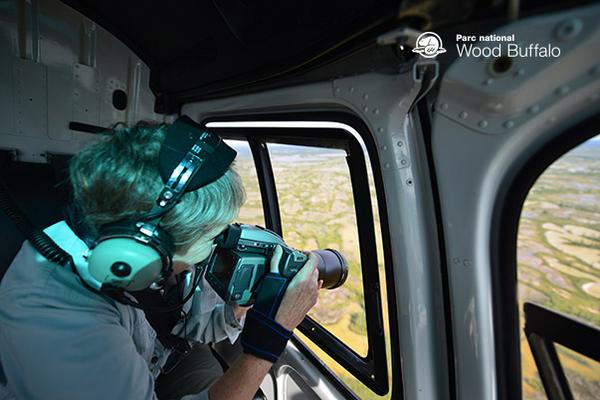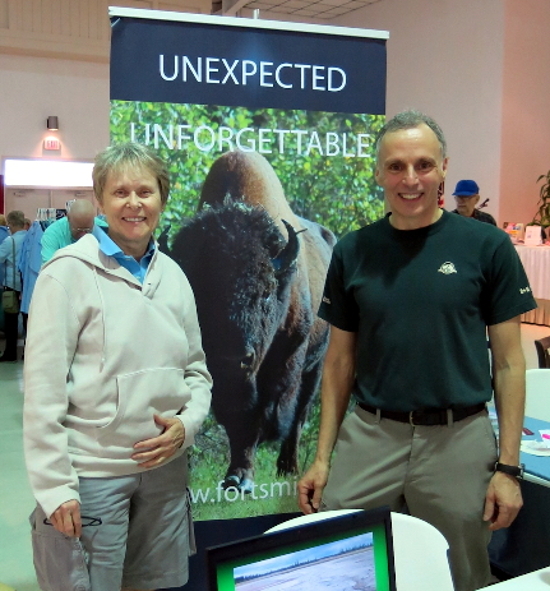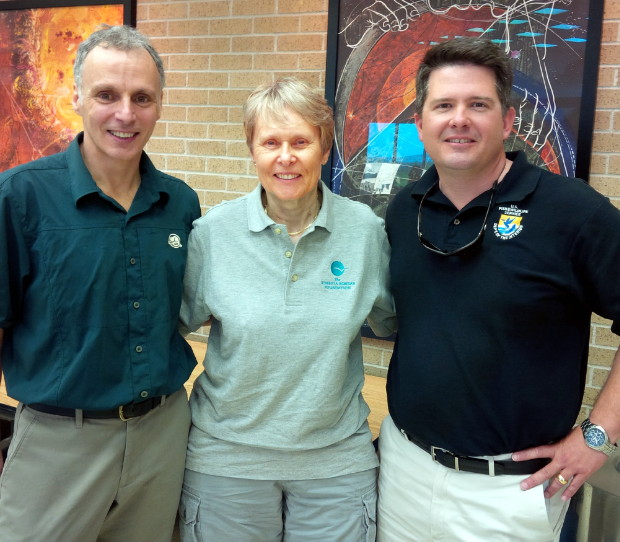Whooping Crane
Scientific name: Grus americana
IUCN designation: Endangered

The Whooping Crane has recovered from the brink of extinction in the early 1940’s with only 15 individuals remaining to just over 800 now between wild populations and breeding programs. The AMASS project features this North American species that continues to be a national symbol for conservation and international cooperation1.
Capable of reaching a height of 1.5 m (5 ft) and having a wingspan of 2.1 m (7 ft), the Whooping Crane is North America’s tallest bird1! It can be easily identified by its white plumage, long neck, red crown, black wingtips and long black legs which trail behind in flight2.
There are three active populations of the Whooping Crane3. The only naturally occurring, self-sustaining wild population breeds exclusively in the wetlands of Wood Buffalo National Park (WBNP) which sits on the border of Alberta and the Northwest Territories in Canada4. This flock completes long spring and autumnal migrations of 4000 km (2485 mi) each way over a period of fifty days each time, across the Great Plains of North America to and from its wintering grounds at Aransas National Wildlife Refuge (NWR) in Texas, USA5.
Hunting and habitat loss because of cropland conversion decimated the Whooping Crane population in the 19th and first half of the 20th century3.
The Whooping Crane population has resurged, thanks to conservation efforts including the establishment of federal legislation and international agreements to protect and recover endangered species (e.g. the Migratory Bird Treaty Act, the Endangered Species Act, the Species at Risk Act); captive breeding and release programs; and the reintroduction of flocks.
Now, the recovery and survival of the endangered Whooping Crane depends highly on conserving the integrity of the wetland habitats found at its breeding, staging, migratory stopover and overwintering sites, all of which are highlighted in the AMASS project.
To learn more, visit our Whooping Crane StoryMap or the links below!
- The Cornell Lab: All About Birds – Whooping Crane
- Canadian Wildlife Federation: Hinterland Who’s Who – Whooping Crane
- USGS – Whooping Cranes past and present
- The Cornell Lab: Birds of the World – Whooping Crane
- Wood Buffalo National Park – Whooping Cranes
Further Resources and Annotated Links

© Parks Canada / JD McKinnon
This article describes how conditions of drought and fire can disrupt breeding areas and impact birds, including the whooping crane.
Within the U.S. Fish and Wildlife Service, the Aransas NWR forms part of a national network of lands and waters set aside and managed to conserve America’s fish, wildlife, and plants.
The Texas Parks and Wildlife Department will work with landowners whose property is inhabited by species endangered or at risk. A sample video from Texas Parks shows Whooping Crane capture and transmitter tagging, along with wetlands-conserving neighbours of wildlife areas:
Along with the sites above, we like the following links for further information and study on the Whooping Crane:
Friends of the Wild Whoopers
The mission of this Whooping Crane preservation organization is “to help preserve and protect the Aransas/Wood Buffalo population of wild whooping cranes and their habitat.” That’s a lot of territory to cover!
Neat Whooper ID section illustrates differences between Whoopers and other large cranes and seabirds and also includes a detailed checklist. A photo gallery includes Whoopers in various life stages, stalking, feeding, and flying. A special “Ask Dr Felipe” feature allows access to FOTWW’s Science Advisor, Dr. Felipe Chavez-Ramirez, PhD.
Hinterland Who’s Who
This cooperative venture between the Canadian Wildlife Service and the Canadian Wildlife Federation specializes in Canadian wildlife – from birds to bears to bees to bog willow to basking sharks. And grows more comprehensive daily.
The Whooping Crane entry holds a downloadable fact sheet, flight silhouette, map, food and breeding facts, plus a set of boxed links that discuss wetlands value and how individuals can help.
All About Birds
The online bird reference of The Cornell Lab of Ornithology, a specialized unit of Cornell University, in New York State. Research, education, and citizen science focused on birds. Excellent resource for North American bird study and online bird courses.
The Whooper page contains sound files, migratory route maps, and cool Life History facts.
International Crane Foundation
A specialized site that features all crane species around the world. Founded by Cornell ornithology graduates. Many valuable resources here.
The Whooping Crane page includes fact sheets, downloadable images, range map, sound files, special rearing and releasing anecdotes and ICF programs.

Dr. Roberta Bondar with Richard Zaidan, Visitor Experience Manager, Wood Buffalo NPC, The Foundation’s partner on Whooping Crane education.
Richard Zaidan, WBNP, Dr. Bondar, Wade Harrell, Whooping Crane Recovery Coordinator, Aransas National Wildlife Refuge
